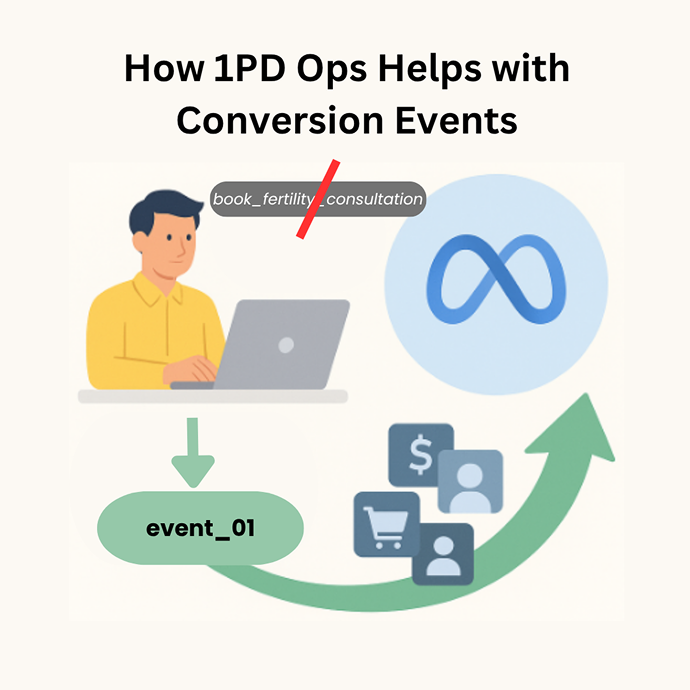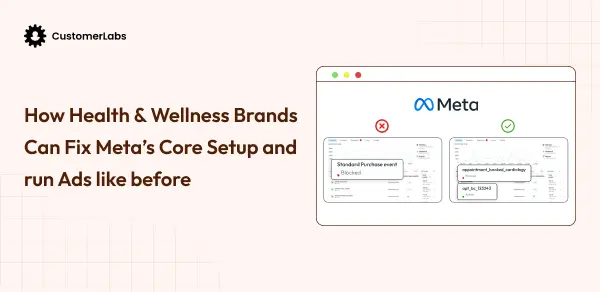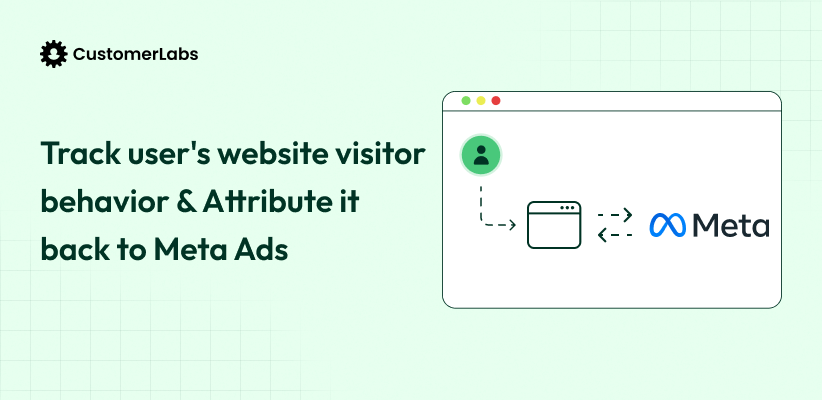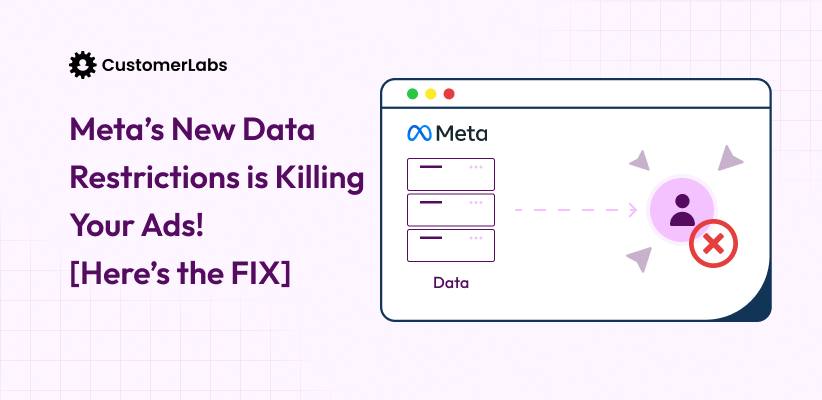There’s a strange feeling in the air for health marketers right now
If your Meta campaigns are suddenly underperforming, ads are getting flagged, audiences are shrinking, and CAPI events are disappearing, it’s not a coincidence.
Your targeting isn’t broken. Your creativity isn’t the issue. And your budget isn’t the problem. Meta has quietly shifted how it handles data for health brands. And if you’re still relying on old playbooks, you’re already falling behind.
Don’t be the one in the group who gets flagged. Be the one who thrives by adapting fast to these new rules like the best marketers already have.
So, what exactly has Meta changed? Could your brand already be on their watchlist? Why is Meta cracking down so hard, and what happens when your account gets restricted? More importantly, what’s the clean fix that still delivers results?
Let’s break it down before your next campaign takes the hit.
The Silent Shift: What Meta Just Changed (And You didn’t Notice)
Meta’s 2025 data policy update is quietly rewriting the rules for every health brand running ads. The changes aren’t obvious, but they’re already affecting your results.
- Restrictions on Data Collection: Meta is tightening how it receives data from Pixel, CAPI events for ad optimization. Even if you’re not collecting names or emails, the way you send data matters.
- Sensitive Health Data: Meta now treats a wide range of health-related info as “sensitive,” even if it’s anonymized. This includes things like appointment bookings, test result downloads, or even visiting certain pages.
- Inference, Not Just Detection: Meta isn’t just looking for obvious health keywords. It’s using patterns and behaviors to infer if your data is health-related, even if you try to hide it.
Still not sure if this affects you? Let’s dig into how Meta decides who’s restricted and how your brand might already be on the list.
Are You (Secretly) on Meta’s Watchlist?
Meta has restricted the data sharing policy for several industries, but the rules aren’t black and white.
Sensitive Industries on Meta’s Radar
| Category | Why It’s Restricted |
| Healthcare & Wellness | Risk of PHI (Protected Health Info) via tracking or ad personalization |
| Financial Services | Sharing of financial status, credit info, or income can violate privacy laws |
| Insurance (Health, Life, Auto) | Policy and claim info can infer health, income, or risk status |
| Legal Services | Attorney-client relationships are confidential and can’t be used for targeting |
| Education (esp. K-12 or student loans) | Involves minors or financial eligibility info |
| Mental Health / Addiction Recovery | Considered highly sensitive under HIPAA and GDPR |
| Sexual Health / Reproductive Services | Protected health category is often auto-flagged |
| Pharmaceuticals / Supplements | Crosses into regulatory and health-based restrictions |
| Political / Social Issues | Must pass Meta’s ad authorization and cannot use personal attributes |
| Employment / Job Training | Job status, unemployment, or income level are personal attributes |
Three-Tiered Restrictions by Meta
Meta’s data restrictions aren’t one-size-fits-all. Meta applies a tiered enforcement system depending on the nature of your data source:
1. Core Setup Restrictions (Mild)
Meta blocks or limits small but important bits of information you normally send with each website visit. These include URL tags (like UTM parameters) and custom event details (like category, plan type, or city name).
Imagine you run a diabetes website with pages for New York, California, and Los Angeles. Normally, Meta could see which city users came from to show better ads. But with restrictions, that city info is blocked, so Meta sees everyone the same.
Impact: You lose the ability to build accurate audiences or measure which campaigns work best. Ads become less relevant, and performance starts to dip.
2. Restrictions on Standard Events (Moderate)
Meta blocks specific user actions that are crucial for ad performance, like tracking when someone books a consultation (Lead), adds a service to cart (AddToCart), or completes a payment (Purchase).
Say you offer lab test bookings. A visitor clicks “Book Now,” fills out the form, and confirms the appointment. Normally, that would be sent to Meta as a Lead or Purchase event to help you optimize ads. Meta blocks that info, so you won’t know which ad got you the bookings.
Impact: Meta loses the signals it needs to learn. It can’t see who’s converting, so it shows your ads to random people, making your campaigns less effective.
3. Full Restrictions (Severe)
Meta completely blocks all data sharing from your site or app. Nothing gets through, not even page views or clicks.
If you run a women’s wellness brand for PCOS and Meta sees health-related data on your site, even by accident, it might fully block tracking. That means your Pixel and CAPI stop working.
Impact: You can’t track visitors. You can’t retarget. You can’t optimize for conversions.
Okay, so maybe you are flagged. But how does Meta know so much about your brand’s data? Here’s what’s triggering detection.
The Invisible Triggers: How Meta Flags Your Data
It’s easy to think Meta is just looking for obvious health forms or HIPAA identifiers. But the reality is more complex.
- The Pixel Sees Everything: That tiny Meta Pixel on your site? It’s tracking every move, page visits, clicks, and form submissions. Visit a page like /thyroid-test? Meta sees it. Click “Book Now” on a PCOS consultation? Meta logs it, including “sensitive or prohibited data.”
- CAPI Doesn’t Save You: Some marketers think switching to server-side tracking (CAPI) will protect them. In reality, it is a wrong move. Because CAPI sends cleaner, more structured data. That means Meta reads it even better. Sending an event called StartTherapySession? You just handed Meta the red flag on a silver platter.
- Behavioral Signals: Meta isn’t just scanning for “health” keywords. It’s reading between the lines:
- Event names like DownloadTestResults or CheckHormoneLevels
- URL paths like /mental-health-support
- UTM tags like utm_source=pcos-quiz
- Clicks on buttons like “View Lab Results” or “Start Session”
Even without personal info, the pattern gives you away.
If Meta’s systems are this strict, what happens when your ad account gets flagged? Let’s break it down.
What Happens When Meta Flags Your Ad Account
The consequences are real, and they can hit your campaigns hard.
- Conversion Events Disappear: Suddenly, your reports stop showing key conversion events. You can’t optimize for what you can’t see.
- Retargeting Lists Shrink: Your audience pools get smaller overnight, making retargeting less effective.
- Lookalikes Lose Power: With less data, your lookalike audiences become less accurate.
- Campaigns Shift Up-Funnel: Meta automatically pushes your campaigns to focus on upper-funnel objectives, like reach or traffic, instead of conversions.
- ROAS Tanks: Your return on ad spend drops, and you can’t figure out why.
We’ve seen brands lose months of progress in a matter of days. It’s not just a technical issue; it’s a business problem.
It’s not the end for your ads. You can fix this in no time.
Let’s talk about what you can do that’s both compliant and performance-focused
What Works: The Clean-Signal Fix with 1PD Ops
If Meta blocks your data, it doesn’t just break tracking; it disrupts your entire growth engine. But with a First-Party Data Ops (1PD Ops) platform like CustomerLabs, you can restore clean, compliant signals that fix ad campaigns that Meta shuts down.
Here’s how 1PD Ops helps you recover one broken piece at a time:
1. Bring Back Conversion Events
- When conversion events like Purchase or Lead disappear, Meta loses its ability to optimize, and you lose performance.
- 1PD Ops automatically scrubs sensitive URLs and event names even before they reach Meta. For example, a URL like /book-therapy-session?type=cardiology gets anonymized to /event123, and a flagged event like book_fertility_consultation is renamed event_01.
- The result? You keep conversion tracking without triggering restrictions.

2. Rebuild Retargeting Lists with Clean Signals
- When Meta blocks health-related parameters, your retargeting audiences shrink fast.
- By filtering out personal data like names, emails, or health terms before they reach Meta, you can safely retarget users based on behavior (e.g., product views, cart actions) without violating policies.
- Custom event tracking, like scrolls, page visits, and clicks, you can rebuild your audience pools using micro-conversions that still show intent.
3. Feed Lookalike Audiences with Compliant Data
Lookalike performance drops when Meta doesn’t have enough clean data to model from.
CustomerLabs lets you collect first-party data with consent, hash identifiers like emails before upload, and replace sensitive events with generic ones. This gives Meta enough compliant data to rebuild high-performing lookalikes without exposing private details.
4. Shift Campaigns Back to Conversions (Not Just Reach)
When flagged, Meta forces your ads to optimize for broad goals like traffic because it doesn’t trust your lower-funnel events.
By enabling server-side tagging with just a toggle, you can regain control over lower-funnel events like Purchase, AddToCart, and Lead without relying on browser-based tracking or risking non-compliance. Meta gets clean, trusted signals, and you get your conversion goals back.
5. Diagnose ROAS Drops with Full-Funnel Visibility
When Meta can’t track conversions, your ROAS tanks and you’re stuck guessing why.
With Looker Studio integration, 1PD Ops gives you custom attribution reporting across the full funnel. You’ll see top-of-funnel signals (like ViewContent) alongside bottom-funnel actions (like Purchase) so you can finally connect spend to revenue, even if Meta’s black box breaks down.
Conclusion
By now, it would have been clear that the old way of “just send everything” doesn’t work anymore with Meta.
However, you can still run high-performing ads without getting flagged by implementing effective tools like 1PD Ops. Using tools like CustomerLabs, you can send clean, approved data that keeps your tracking and results intact.
1PD Ops isn’t just a tracking solution; it’s a recovery plan when Meta shuts down your signal. By cleaning, anonymizing, and safely activating your first-party data, help restore performance without risking compliance.
The brands that fix this now will keep growing. The ones who wait? They’ll get left behind.
Fix what’s broken. Stay compliant. And keep growing.








